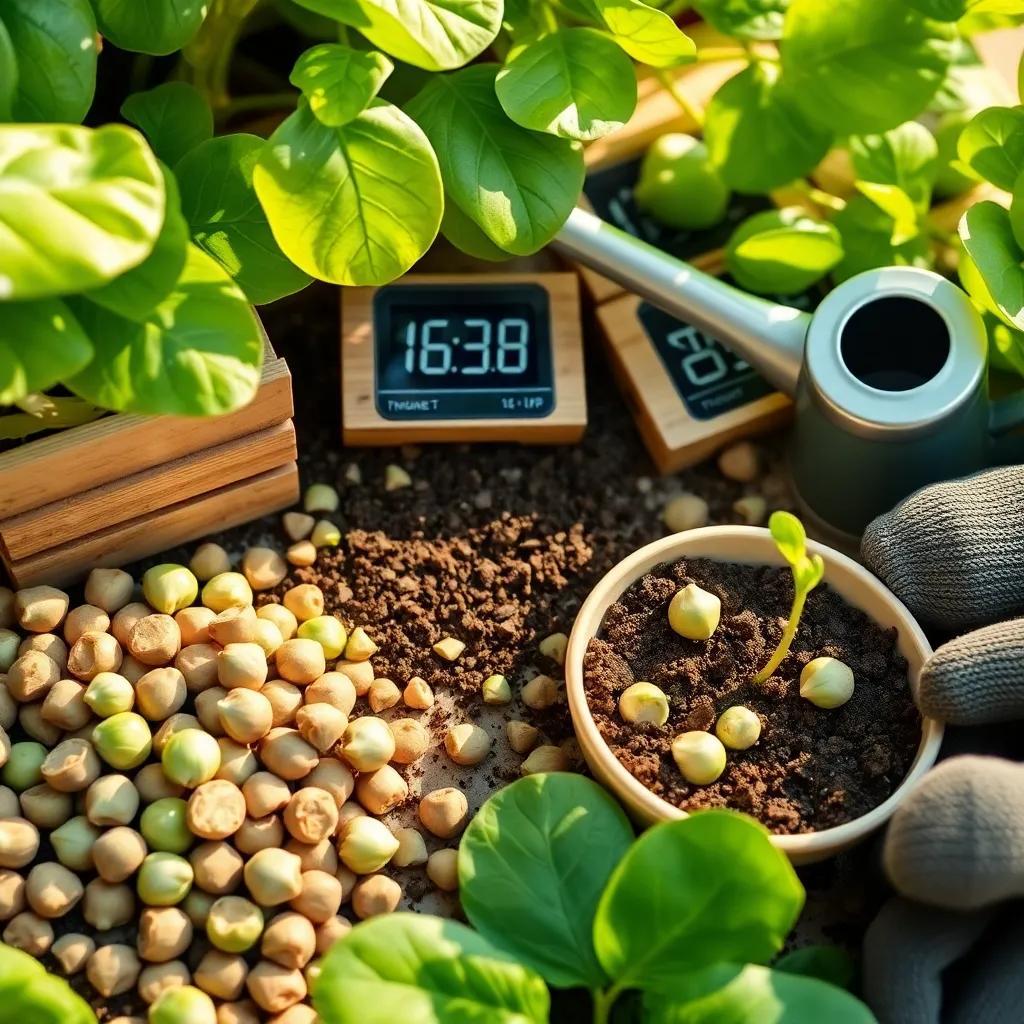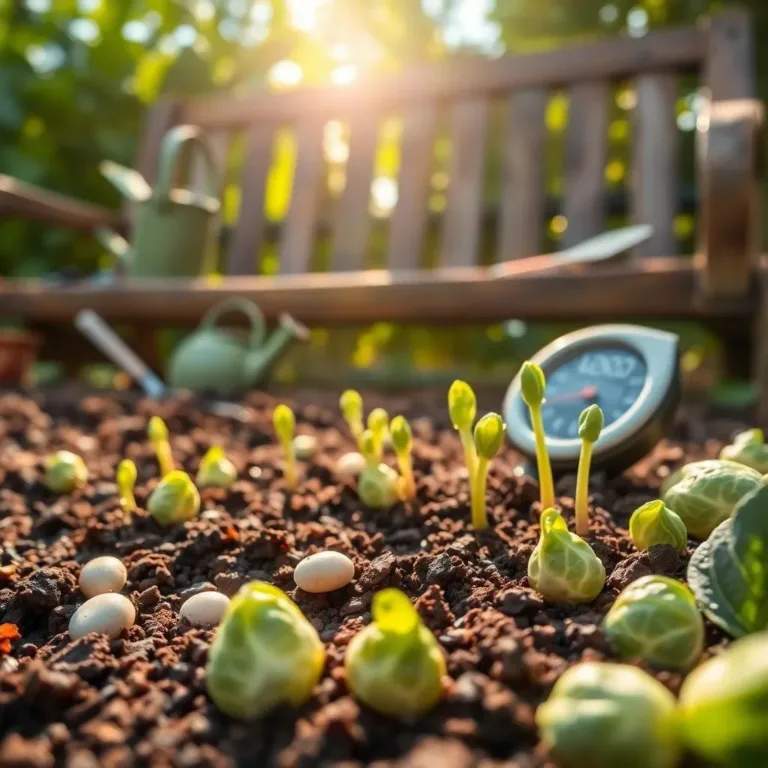Are you ready to grow your own Brussels sprouts? It’s such a fun adventure! Whether you’re a gardening newbie or a seasoned plant parent, understanding how to germinate these tasty veggies can lead to a thriving garden and delicious meals. Stick around as I share all the exciting details about germination, ideal conditions, and tips for ensuring your sprouts grow strong and healthy!
Understanding the Germination Process of Brussels Sprouts
Germination is an exciting step in growing your own Brussels sprouts! It’s like watching a magic show where tiny seeds transform into baby plants right before your eyes! So, what exactly happens during this fascinating process? Let’s break it down!
When you plant a Brussels sprout seed, it starts off as a dry little nugget. But don’t let its small size fool you! Once it finds the right conditions, it’s ready to spring into action. The first thing a seed does is absorb water. This is called imbibition, and it’s like the seed taking a nice drink after a long nap! Once the seed gets enough moisture, it begins to wake up.
As the seed soaks up water, enzymes inside kick into gear. They start breaking down stored nutrients, turning them into energy for the growing seedling. This energy helps the seed push through its outer coating and grow its first tiny root, called the radicle. This little root is very important because it anchors the seedling in the soil and starts sucking up moisture and nutrients.
As the root develops, the hypocotyl (that’s just a fancy word for the stem) begins to grow. It pushes upwards, breaking through the soil and reaching for the sun! It’s like the seed saying, “Here I am, world!” This part of the plant will eventually turn into the stem and leaves of your Brussels sprout plant.
Overall, the germination process usually takes about 7 to 14 days. Factors like moisture, temperature, and even the quality of the seed can affect how quickly it happens. If everything goes just right, you’ll soon have cute little sprouts popping up, ready to grow into delicious mini-cabbages!
Factors Influencing Brussels Sprout Germination Time
So, what really makes a difference in how fast our Brussels sprout seeds germinate? Great question! Let’s chat about some of the big factors that affect this process. Think of it like a recipe where the ingredients can change how your dish tastes!
- Temperature: Brussels sprout seeds love the cool weather! They germinate best in soil temperatures of 60 to 70°F (15 to 21°C). If it’s too hot, they might just decide to take a snooze instead of sprouting! If the temperatures are too low, they’ll just be sluggish. It’s like having a cozy blanket for your seeds!
- Moisture: Consistent moisture is a must-have! Seeds need to be kept evenly moist but not soggy. Too much water can drown them, while too little can make them dry out. It’s like finding the perfect balance between a cozy rain and a sunny day!
- Seed Quality: Not all seeds are created equal! Fresh, high-quality seeds sprout quicker and have a better chance of thriving. So always pick your seeds from a trusted source. It’s like choosing the best ingredients for your favorite recipe!
- Light: Here’s a fun fact! Brussels sprout seeds actually prefer to germinate in darkness. So make sure to cover them with a thin layer of soil! Once they sprout, they can start soaking in all that sunshine.
- Seed Depth: Plant those seeds about 1/4 to 1/2 inch deep in the soil. Too shallow and they might dry out. Too deep, and they could struggle to break through. It’s all about giving them the right home!
With all these factors in mind, it’s easier to understand why some seeds sprout faster than others. Keep these tips handy, and you’ll be a Brussels sprout guru in no time! Happy gardening!

Ideal Conditions for Germinating Brussels Sprout Seeds
Creating the perfect environment for Brussels sprout seeds to germinate can feel like hosting a cozy party! You want everything just right so your seeds feel comfortable and happy. Let’s talk about the ideal conditions to help them thrive.
- Temperature: Brussels sprout seeds prefer cooler conditions, so keep the soil between 60 to 70°F (15 to 21°C). If it’s too warm, the seeds might sleep longer than expected! Use a thermometer to keep an eye on the temperature, and if it gets too hot, some shade or mulch can help cool things down.
- Moisture: Think of moisture like a warm hug for your seeds. They need the soil to be consistently moist but not soggy. Water gently and often, being careful not to flood them. You might use a spray bottle to mist the soil surface, keeping it just right!
- Light: Here’s a little surprise: Brussels sprout seeds actually prefer darkness while germinating. Cover them with about 1/4 to 1/2 inch of soil to help them feel snug. Once they sprout, they’ll be ready for some sunshine!
- Seed Quality: Always go for the freshest seeds you can find! High-quality seeds from reputable sources will sprout faster and healthier. It’s like choosing the ripest fruits from a market!
- Air Circulation: Good air circulation is a must! It helps prevent diseases and keeps your seedlings happy and healthy. Don’t overcrowd them and give them some space to breathe.
By providing these ideal conditions, you’ll be setting your Brussels sprouts up for success. Just imagine seeing those little sprouts peeking through the soil—what a joy that will be!
Typical Germination Timeline for Brussels Sprouts
Now that we’ve set the stage for our seeds, let’s talk about the germination timeline. Knowing what to expect can really help you stay excited and patient as you nurture your Brussels sprouts! Here’s a general overview of what happens during those magical days.
- Days 1 to 3: After planting, your seeds are busy soaking up water! You might not see any action just yet, but trust me, the seeds are preparing for their big debut! It’s like they’re stretching and getting ready to sprout!
- Days 4 to 7: This is when the fun begins! You might start to notice small roots, known as radicles, poking through the soil. They’re working hard to find stability and nutrients. Keep that soil moist—your little friends are growing!
- Days 8 to 14: Get ready for excitement! The radicle is now growing, and the hypocotyl will push through the soil, bringing the first leaves, called cotyledons. These tiny leaves might look a bit folded, but they’re ready to take on the world!
- Days 15 to 21: By this time, your seedlings should be looking more robust! The cotyledons will unfurl, and the first true leaves will follow. They’ll be catching some light and growing stronger each day!
- Day 22 and beyond: If you’ve been taking good care of your sprouts, they’ll be well-established and ready for transplanting! They’ll continue to thrive, eventually giving you those delicious mini-cabbages.
Each seed is unique, so some may sprout faster than others. Just keep monitoring moisture and light, and soon enough, you’ll be enjoying your very own Brussels sprouts!
Tips for Ensuring Successful Brussels Sprout Germination
Now that we know about germination and the timeline, let’s dive into some tips that can help make the process even smoother! Think of these as little nuggets of wisdom to ensure your Brussels sprout seeds thrive.
- Select Quality Seeds: Always start with the best! Look for seeds that are fresh and from a trusted source. An old or low-quality seed could lead to disappointing results!
- Keep it Cool and Moist: Remember those ideal conditions we talked about? Stick to the right temperature and moisture levels to create a perfect environment for germination.
- Check Soil Depth: When planting, aim for 1/4 to 1/2 inch depth. This helps them stay protected while also being close enough to the surface to sprout easily.
- Rotate the Seedlings: If your seedlings are indoors, consider rotating them occasionally for even light exposure. This helps them grow straight and strong, preventing them from leaning toward the light.
- Don’t Rush to Transplant: Once your seedlings have developed their first true leaves, they may be ready to move, but don’t hurry! Make sure they’re sturdy and healthy before transferring them to bigger pots or the garden.
- Hardening Off: Before moving your seedlings outdoors, harden them off! Gradually expose them to outdoor conditions over a week to help them adjust to their new environment. It’s like giving them a little vacation before their big move!
With these tips in mind, you’re all set for a successful germination journey! Just keep an eye on those little sprouts, and soon you’ll be nurturing them into strong Brussels sprout plants ready for harvesting. Happy gardening!

